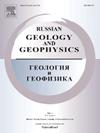拉普捷夫海Anabar湾Nordvik半岛上侏罗统和下白垩统(Urdyuk-Khaya组和Paksa组)微化石、高分辨率地层学、地球化学和岩性
IF 1
4区 地球科学
Q3 GEOSCIENCES, MULTIDISCIPLINARY
引用次数: 1
摘要
摘要/ Abstract摘要:本研究旨在提高拉普捷夫海Anabar湾Nordvik半岛类型剖面上侏罗统和下白垩统高分辨率生物地层学水平。利用结果确定了13个有孔虫生物地层单元、9个囊藻生物地层单元和8个孢粉植物生物地层单元在带级和局部带级上的演替。根据新的资料,证明了该剖面的地层连续性为中伏统和下伏统,而以前认为该剖面存在大的地层间断。建立带具有可变相关电位。讨论了以菊石为基础分段的不同版本,建议的比额表是合理的。在特提斯和北极地区侏罗纪-白垩纪边界附近,定义了一个基于钙质囊/钙质囊的参考水平,提供了全球对比和校准。讨论了研究剖面的磁地层细分及其与特提斯地区的比较。结合生物地层资料,提出的上侏罗统和瓦兰吉尼亚统下半段δ13Corg曲线可作为北半球不同地区详细对比的工具。在北极地区确定了上伏尔加统和北贝里亚统的碳同位素组成旋回性,以及伏尔加统和下瓦兰吉尼亚统的碳同位素事件。测定了研究剖面的地球化学参数(Corg、δ13Corg和氢指数)的分布,证明了剖面的地球化学分层和主要氧化物组成的变化。在帕克萨组(上伏尔加)底部,地球化学参数发生了急剧变化。确定了“地表下叶绿素最大值”的分布区间。研究表明,第一二asterene地球化学亚层中同位素轻有机碳的高浓度是由浮游植物高产引起的,并在有利于有机质保存的还原性条件下沉积。对所研究岩石主要氧化物组成的分析表明,所研究岩石化学组成的变化反映了其矿物学和岩石学的变化。本文章由计算机程序翻译,如有差异,请以英文原文为准。
Microfossils, High-Resolution Stratigraphy, Geochemistry and Lithology of the Upper Jurassic and Lower Cretaceous (Urdyuk-Khaya and Paksa Formations) in the Nordvik Peninsula, Anabar Bay, Laptev Sea
Abstract —The goal of this study was to improve the high-resolution biostratigraphy of the Upper Jurassic and Lower Cretaceous in the type section on the Nordvik Peninsula, Anabar Bay, Laptev Sea. The results were used to identify a succession of 13 foraminiferal biostratigraphic units, 9 dinocyst units, and 8 palynofloral biostratigraphic units in the rank of zones and local zones. Based on new data, the stratigraphic continuity of this section is proved for the Lower and Middle Volgian, where a major stratigraphic hiatus was previously assumed. The established zones have variable correlation potential. Different versions of the subdivision of the section based on ammonites are discussed and the proposed scale is justified. A reference level based on calcispheres/calcareous dinocysts is defined providing global correlations and calibration of beds near Jurassic–Cretaceous boundary in the Tethyan and Arctic regions. The magnetostratigraphic subdivision of the studied section and its comparison with the Tethyan regions are discussed. Together with biostratigraphic data, the proposed δ13Corg curve in the Upper Jurassic and lower part of the Valanginian can be a tool for detailed correlations in different regions of the Northern Hemisphere. The cyclicity of carbon isotope composition in the Upper Volgian and Boreal Berriasian and isotope events in the Volgian and Lower Valanginian are determined within the Arctic region. The distribution of geochemical parameters (Corg, δ13Corg and hydrogen index) is determined in studied section, geochemical stratification of the section and variations in major oxide compositions are demonstrated. A sharp change in geochemical parameters is identified at the base of the Paksa Formation (Upper Volgian). The distribution interval of the “subsurface chlorophyll maximum” is determined. The study shows that high concentrations of isotopically light organic carbon in the first diasterene geochemical subhorizon were caused by high phytoplankton productivity and were deposited under reducing conditions favorable for preservation of organic matter. The analysis of major oxide compositions of the studied rocks revealed that variations in the chemical composition of the studied rocks reflect changes in their mineralogy and petrography.
求助全文
通过发布文献求助,成功后即可免费获取论文全文。
去求助
来源期刊

Russian Geology and Geophysics
地学-地球科学综合
CiteScore
2.00
自引率
18.20%
发文量
95
审稿时长
4-8 weeks
期刊介绍:
The journal publishes original reports of theoretical and methodological nature in the fields of geology, geophysics, and geochemistry, which contain data on composition and structure of the Earth''s crust and mantle, describes processes of formation and general regularities of commercial mineral occurrences, investigations on development and application of geological-geophysical methods for their revealing. As to works of regional nature, accelerated publication are available for original papers on a variety of problems of comparative geology taking into account specific character of Siberia, adjacent Asian countries and water areas. The journal will also publish reviews, critical articles, chronicle of the most important scientific events, and advertisements.
 求助内容:
求助内容: 应助结果提醒方式:
应助结果提醒方式:


